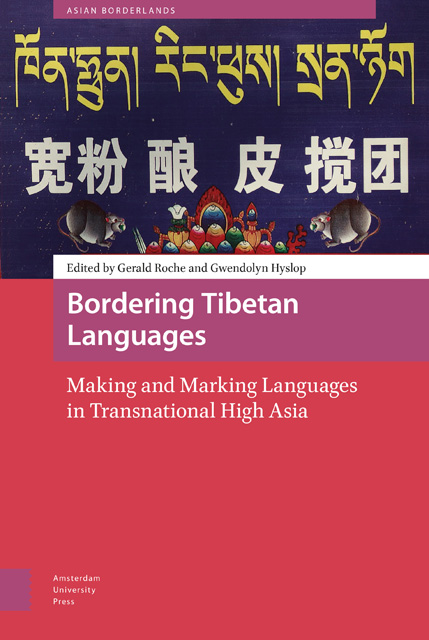Book contents
- Frontmatter
- Table of Contents
- Acknowledgements
- About the Cover Image
- 1 Introduction: Bordering Tibetan Languages: Making and Marking Languages in Transnational High Asia
- 2 Playing with Language Boundaries: Heteroglot Standard Language Ideology and Linguistic Belonging among Amdo Children
- 3 The Role of Classical Tibetan (Chöke) on the Development of Kurtöp, a Language of Bhutan
- 4 Reimagining Rongring without Tibetan Buddhist Influence
- 5 Glottonyms, Identity, and Language Recognition in the Eastern Tibetosphere
- 6 On the Yak Horns of a Dilemma: Diverging Standards in Diaspora Tibetan
- 7 Changing Identity and Linguistic Practices in Nubri: Veiled Language Endangerment in the Nepalese Tibetosphere
- 8 Borderline Dominance: Transnational Tibetan Language Politics in the Himalayas
- 9 Borders: In Conclusion
- Tibetan Language Summaries
- Asian Borderlands
- Index
7 - Changing Identity and Linguistic Practices in Nubri: Veiled Language Endangerment in the Nepalese Tibetosphere
Published online by Cambridge University Press: 24 November 2022
- Frontmatter
- Table of Contents
- Acknowledgements
- About the Cover Image
- 1 Introduction: Bordering Tibetan Languages: Making and Marking Languages in Transnational High Asia
- 2 Playing with Language Boundaries: Heteroglot Standard Language Ideology and Linguistic Belonging among Amdo Children
- 3 The Role of Classical Tibetan (Chöke) on the Development of Kurtöp, a Language of Bhutan
- 4 Reimagining Rongring without Tibetan Buddhist Influence
- 5 Glottonyms, Identity, and Language Recognition in the Eastern Tibetosphere
- 6 On the Yak Horns of a Dilemma: Diverging Standards in Diaspora Tibetan
- 7 Changing Identity and Linguistic Practices in Nubri: Veiled Language Endangerment in the Nepalese Tibetosphere
- 8 Borderline Dominance: Transnational Tibetan Language Politics in the Himalayas
- 9 Borders: In Conclusion
- Tibetan Language Summaries
- Asian Borderlands
- Index
Summary
Abstract
This chapter introduces Nubri Valley – the people, the place, the language – presenting results from a recent sociolinguistic survey that establishes internal variation as well as external pressures on the language. As a community of ethnic Tibetans in Nepal, crossing the border has slowly resulted in a shift of focus towards Kathmandu in many ways. Changing attitudes and evolving social practices are resulting in a marked shift in language use in the younger generations. Superficially, the Nubri language appears quite vital within the valley. However, I show how an examination of different borders in the sociolinguistic landscape helps leads us to a much clearer understanding of the actual linguistic vitality, revealing a serious threat to its continued survival.
Keywords: Nubri, sociolinguistics, language attitudes, linguistic practices, language vitality, language endangerment, Tibeto-Burman, Nepal
Tibetic languages in Nepal
Situated between the Tibet Autonomous Region of China and India, Nepal is home to about 29 million people and more than 120 languages. Most of the languages of Nepal belong to the Indo-Aryan group of Indo-European languages, including the national language, Nepali. The majority of people (more than 80%) are speakers of an Indo-Aryan language, but the greatest diversity is found in the Sino-Tibetan languages, spoken by about 17% of the population, though constituting over half the languages represented in the last census (and there are potentially more that are as yet undescribed). The remaining less than 1% of the population use Austro-Asiatic or Dravidian languages, sign languages, or language isolates (or did not participate in the 2011 census) (Central Bureau of Statistics, 2012; Grimes, 1992; Bradley, 1997; Genetti, 2004).
The over 60 Tibeto-Burman languages found in Nepal are typically spoken outside of urban centres. Some major groups that are found in Nepal include Tibetic, Magaric, Tamangic, Newar, and Kiranti, as well as other smaller groups such as Raji-Raute, Chepangic, Baram-Thami, and Kuke (e.g. Hale, 1982; DeLancey, 1987; Matisoff, 1991; Van Driem, 2001). The Tibetic languages within Nepal are spoken by communities situated in the mountainous regions along the ∼ 1,400 km northern border with Tibet that runs through the Himalayas (See Figure 7.1). This region is home to eight of the ten tallest peaks in the world, where the deep valley floors may be at altitudes over 4,000 m, in a landscape scored by gorges and rivers, clearly delineating regions and hindering easy movement.
- Type
- Chapter
- Information
- Bordering Tibetan LanguagesMaking and Marking Languages in Transnational High Asia, pp. 157 - 174Publisher: Amsterdam University PressPrint publication year: 2022



